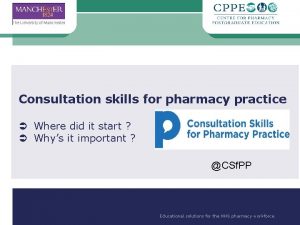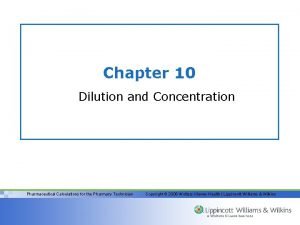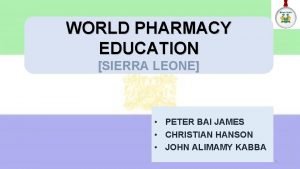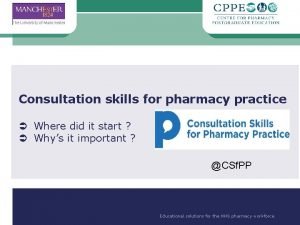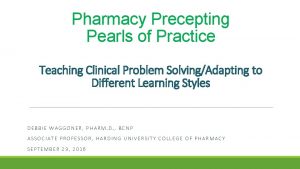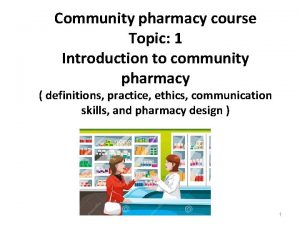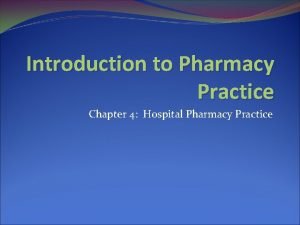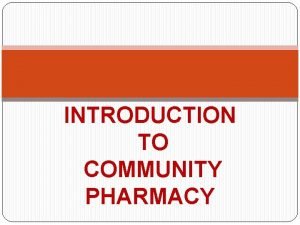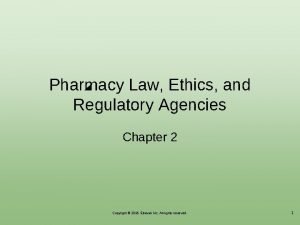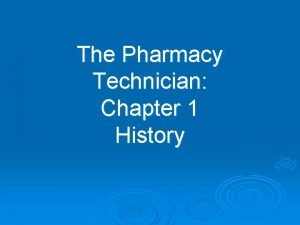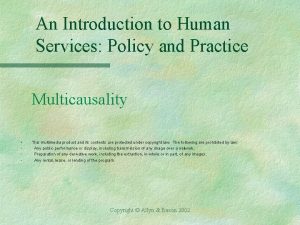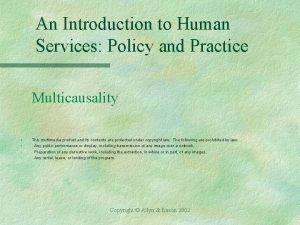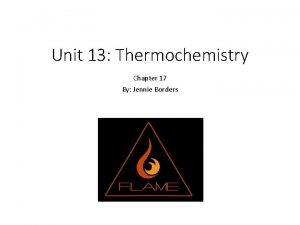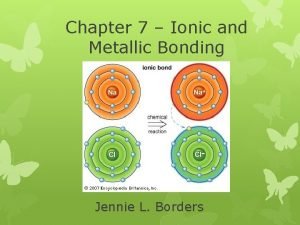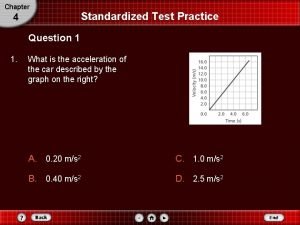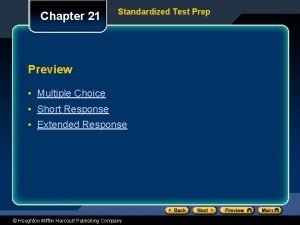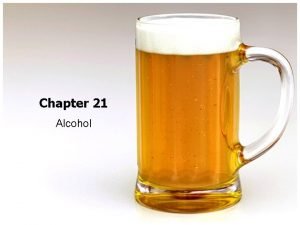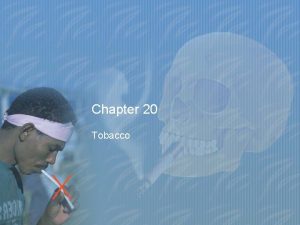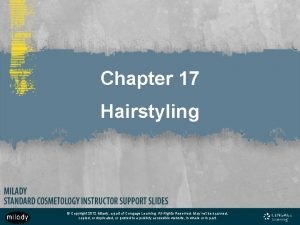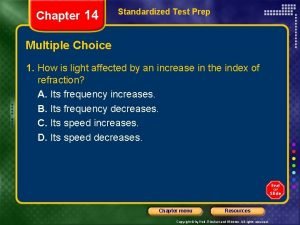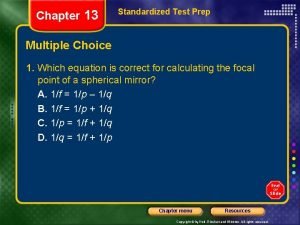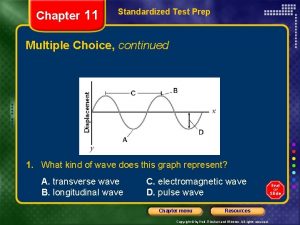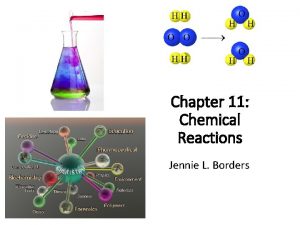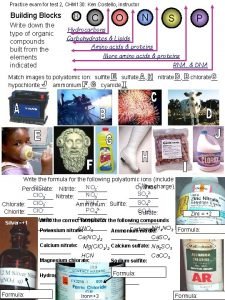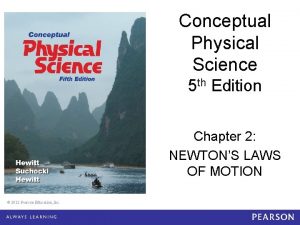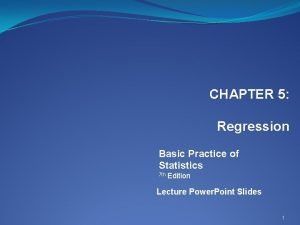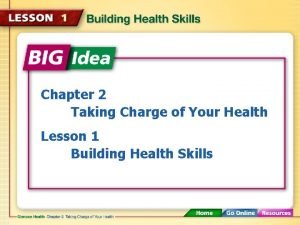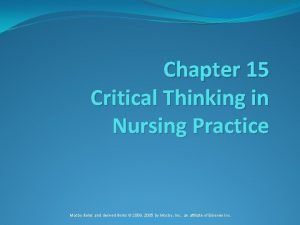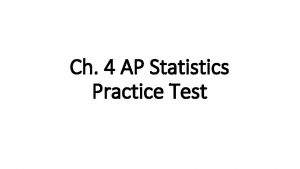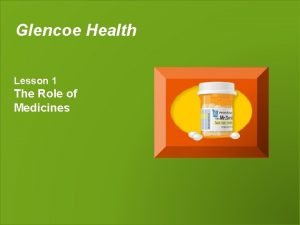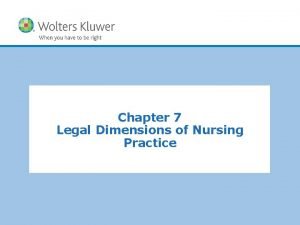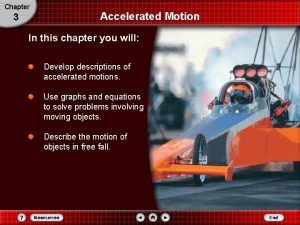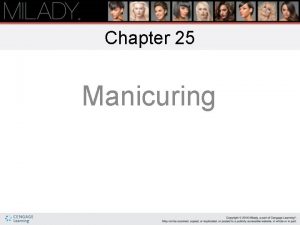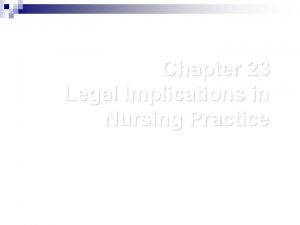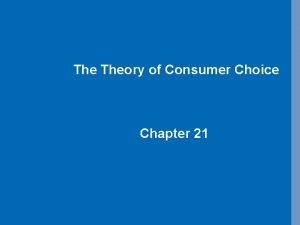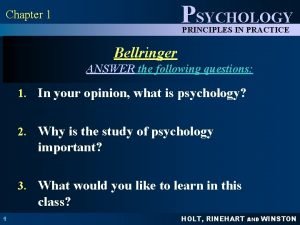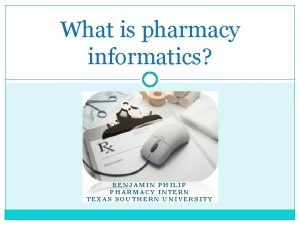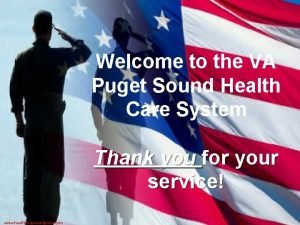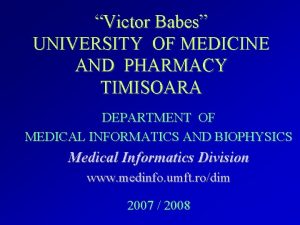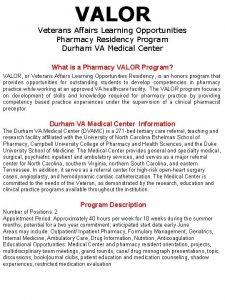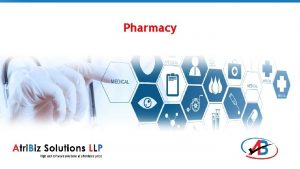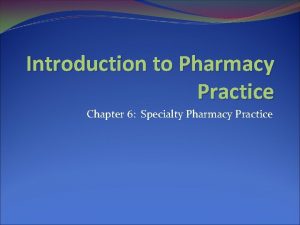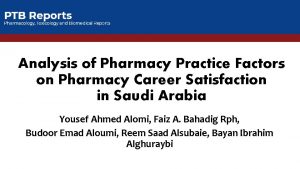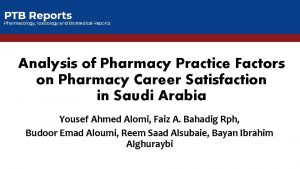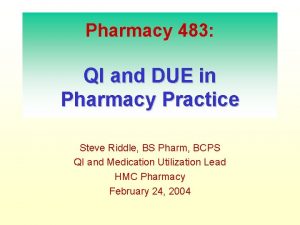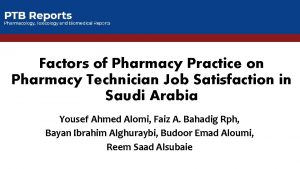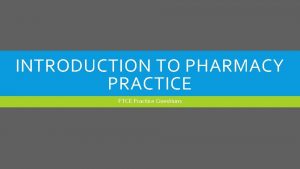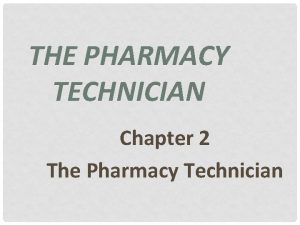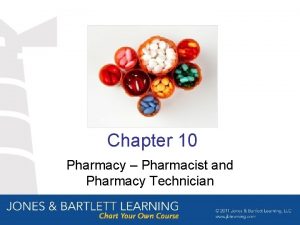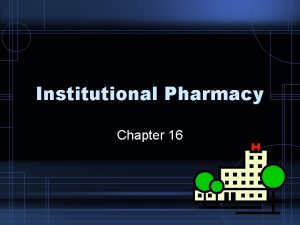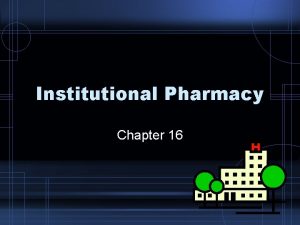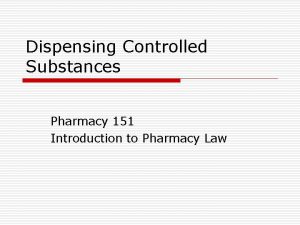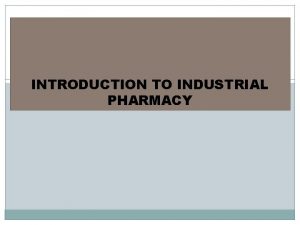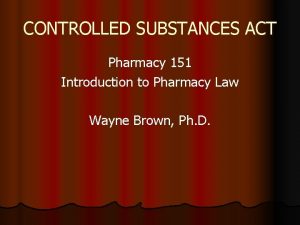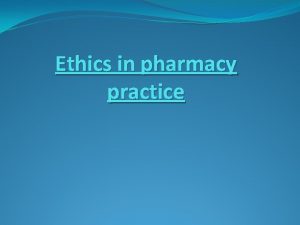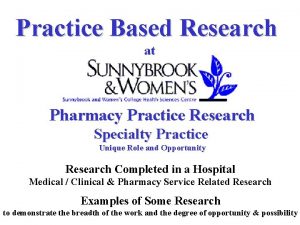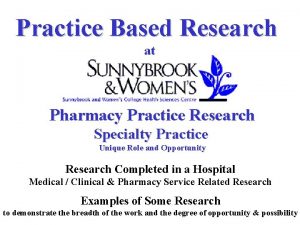Introduction to Pharmacy Practice Chapter 1 Introduction to






















































- Slides: 54

Introduction to Pharmacy Practice Chapter 1: Introduction to Pharmacy

Learning Outcomes • • • Compare & contrast technician & pharmacist roles Understand licensing, certification, registration terms Describe advantages of formal training for technicians Describe a variety of pharmacy practice settings Describe characteristics of a professional

Learning Outcomes List tasks that pharmacy technicians perform in various pharmacy settings Describe the concept of pharmaceutical care Define medication therapy management Explain why the use of outpatient pharmacy & medical services is increasing

Key Terms Pharmacist Pharmacy technician Certification Licensure Registration

Key Terms Accreditation Health-system pharmacy Home health care Medication therapy management (MTM) Pharmaceutical care

Basics Pharmacology: study of drugs & their actions Pharmacokinetics: understanding of how drugs are absorbed, distributed, metabolized, & eliminated by body Pharmaceutics: preparation & dispensing of drugs

Roles of Pharmacy Staff • Pharmacy technicians – Skilled in practical or mechanical aspects – Perform routine, day-to-day functions that do not require judgment of pharmacist • • repackaging medications maintaining medication inventory • Pharmacists – Responsible for technicians’ activities & performance – Engage in activities that require professional judgment – Educating patients about their medications – Suggesting medication alternatives to physicians

Training • Pharmacy Technician Certification Board (PTCB) – National certification program • • administers nationally-accredited pharmacy technician certification examination pharmacy technician performs activities as the result of having certain knowledge & skills • Training requirements for pharmacy technicians vary from state to state & from employer to employer

Hospital Technician Example – Might require high school diploma – Experience and position related to level of responsibility • Hospital pharmacy technician 1 (PT-1) – newly hired technician – fills automated medication dispensing cabinets • Hospital pharmacy technician 2 (PT-2) – 5 years job experience – fills automated medication dispensing cabinets – charges & credits patient accounts – compounds intravenous solutions – inventories narcotics

Community Technician Example • PT-1 – receives prescriptions from patients – checks out patients at cash register • PT-2 – enters data in computerized patient profiles – fill & label prescriptions – review patient insurance information

Technician Advanced Practice Tech-check-tech allowed in some states technicians check work of other technicians under the supervision of a pharmacist Automated technology day-to-day operations & upkeep of systems computerized narcotic inventory control preparation & compounding of IV & sterile products

Patient safety • Top priority for all pharmacists & pharmacy technicians right drug right dose right time right route right patient • Technicians – may be responsible for preparation of drugs – enter patient information into computer profile for later verification by pharmacist • Errors can cause potentially fatal outcomes • Technicians play key role in minimizing risk of errors

Technician Training • Informal on-the-Job Training • Learn skills needed to perform a particular job – – fill prescriptions automated medication dispensing cabinets compound IV solutions or medications enter prescription information into computer database • Informal training situations – pharmacist or technician who is familiar with job often instructs trainee

Technician Training • Structured on-the-job Training – training course developed by the employer – classroom teaching combined with hands-on experience – may last from a week to six months • • aseptic (sterile) technique, pharmaceutical calculations technician responsibilities pharmacy rules & regulations patient confidentiality organizational policies & procedures employee responsibilities

Technician Training • Formal Programs Community & technical college programs – broader in scope than on-the-job training – six to twenty-four months to complete – programs typically include: • • • technical duties related to pharmacy medical terminology pharmaceutical calculations drug distribution systems IV admixture procedures medication packaging techniques

Technician Training • Formal Programs Continued • Technicians gain skills, knowledge, & experience by – attending classes – participating in labs – completing clerkships • After completion of many of these programs students may earn – associate degrees – pharmacy technician certificates • Most programs offer – full-time, part-time, & night classes – financial assistance to those individuals who qualify – online distance learning programs

Pharmacist Training • School – Two years of prerequisite courses – Professional college degree is doctor of pharmacy (Pharm. D) – Older pharmacists may hold a bachelor of science (BS) in pharmacy • License – pharmacists must be licensed by the state’s BOP – licensed pharmacists supervise technicians – pharmacists must have degree in pharmacy to take the licensing examination

Pharmacist Training • Includes advanced training in pharmaceutical sciences • Learn to use professional judgment • Must determine appropriateness for each patient every time prescription is filled: – verify that medication is appropriate for patient’s condition – dosage is correct – patient is not allergic to drug – prescribed medication will not interact with other meds – must educate patient on how to take medication properly – alert patient to possible side effects of drug

Advanced Pharmacist Training • Elective Residency – 1 or 2 year postgraduate training programs – provide opportunity to gain clinical experience – usually in hospital, ambulatory, or community settings – after earning a degree • Elective Fellowships – usually 2 -3 years long – focus on pharmacy research rather than clinical pharmacy practice

Levels of Endorsement Accreditation Process of vouching for conformance with criteria Certification voluntary process to grant recognition to individual lets public know of level of knowledge & skill Credentialing verification of pharmacist’s ability to provide patient care Licensure government agency grants permission to individual public health, safety, & welfare will be reasonably well protected Registration process of making list or being enrolled in an existing list

Accreditation/Certification • Accredited pharmacy technician programs • Certification examinations – assure that pharmacy technicians: • • have met a predefined set of standards possess an established set of skills & knowledge • May provide advantages in terms of job responsibilities, salary, & seniority

Technician Certification • Scope of Pharmacy Technician Practice developed from • validated task analysis – what pharmacy technicians actually do – what knowledge they need to effectively perform those task • Pharmacy Technician Certification Board (PTCB) • a national pharmacy technician certification program • States differ in technician requirements • some states require registration of pharmacy technicians • some states require certification • No national requirement for certification at this time

PTCE • Pharmacy Technician Certification Examination • To take examination candidates must – have high school diploma or GED – submit appropriate application form – pay fee – ineligible if – – convicted of drug- or pharmacy- related felony any felony convictions any time during previous 5 years

PTCE • 2 -hour, closed-book, computer based examination • 80 multiple-choice questions + 10 non-scored questions • Score is based on number of correctly answered questions

PTCE Tests in 3 Function Areas I Assisting pharmacist in serving patients 66% – dispensing prescriptions – distributing medications & collecting & organizing information II Maintaining medication & inventory systems 22% – purchasing medications & supplies – controlling inventory – storing, preparing, distributing medications III Participating in management of pharmacy practice 12% – human resources, facilities & equipment, & information systems

Passing the PTCE Candidates who pass the exam may use designation CPh. T (certified pharmacy technician) after their names

To Maintain Certification • Technicians must recertify every two years – complete at least 20 hours of continuing education – maximum of 10 hours may be earned at the technician’s workplace under the direct supervision of a pharmacist • • hours must be special assignments or training regular work hours do not apply – at least 1 hour of continuing education must be related to pharmacy law

ICPT Institute for the Certification of Pharmacy Technicians Exam for Pharmacy Technicians Certification (Ex. CPT) On-demand, computer-based format Eligibility requirements to take Ex. CPT are similar to those of PTCE Two-hour test with 110 multiple-choice questions 10 are not counted in score

Ex. CPT-Question Categories 1. Regulations & Technician Duties (25%) – Technician duties & general information, controlled substances, & other laws & regulations 2. Drugs & Therapy (23%) – drug classification & most frequently prescribed medications 3. Dispensing Process (52%) – Prescription information, preparing/dispensing prescriptions, calculations, sterile products, & unit dose & repackaging

Program Accreditation ASHP is the only organization that specifically accredits pharmacy technician training programs vocational, technical, & community colleges hospitals chain drug stores military branches

Accreditation standardizes the formal training that pharmacy technicians receive guidelines on how to train competent pharmacy technicians training programs must meet minimum requirements set by ASHP to earn accreditation

Goals of ASHP Accreditation • Upgrade & standardize technician training • assist & recognize training programs • Provide criteria to help trainees select a program • Provide pharmacies with a competency tool • Assist in advancement & professional development of pharmacy technicians

Professionalism Definition: Actively demonstrating attitudes, qualities, & behaviors of a person well educated in an area of specialized knowledge putting the needs of others before one’s own refers to way in which members of a profession present themselves & communicate with others

Professionalism • Code of Ethics for Pharmacy Technicians – Outlines 10 guiding principles for technicians • Practical examples of professional conduct include – respect for patients’ privacy – keeping patient information confidential – participation in continuing education courses – honest, conscientious attitude

Professionalism • Personal appearance communicates a message • Join a membership organization – continuing education opportunities – job placement services – subscriptions to pharmacy technician journals & newsletters – online discussion groups & networks

Pharmacy Practice Settings • • Community Pharmacy Mail-Order Pharmacy Benefit Managers & Managed Care Hospital Pharmacy Home Health Care Long-Term Care Specialty Pharmacy Services

Community Pharmacy • Corner drugstore • Local retail or grocery store pharmacy • chain or independently owned • Technicians in community settings – prepare prescription labels for checking by a pharmacist – order & maintain drug inventory – process insurance claims – operate a cash register

Mail-Order Pharmacy Prescriptions filled & refilled through the mail No face-to-face contact with patients Technicians’ duties in a mail-order pharmacy are similar to those in community setting

Pharmacy Benefit Managers • PBM • Oversees prescription medication programs • Processes & pays prescription medication insurance claims • Develops & maintains a medication formulary • Technicians who work in a PBM environment • do not have direct patient contact • Pharmacists manage drug therapy on a global scale

Managed Care • Type of health insurance program – Patients pay a blanket fee for their health care services • “The application of management principles to achieve maximum health outcomes at the lowest cost” • Managed care programs often operate ambulatory clinics & hospitals

Hospital Pharmacy • Pharmacists are directly involved with patient care – daily interactions with physicians, nurses, & other s – develop plans of pharmaceutical care – monitor the patients’ drug therapy – may provide specialized services – – – pediatrics oncology infectious diseases nutrition support drug information

Hospital Pharmacy Pharmacists evaluate trends in medication use develop guidelines for medication use educate patients & health care professionals, implement & maintain drug distribution systems interdisciplinary work within & outside pharmacy department

Hospital Pharmacy technicians in hospitals work with pharmacists to accomplish many of the pharmacy’s goals may enter physician medication orders into the pharmacy computer system prepare IV drug admixtures repackage & label unit dose medications

Hospital Pharmacy technicians in hospitals restock automated dispensing cabinets deliver medications complete paperwork for quality assurance or billing purposes may dispense medications from a preapproved list

Home Health Care Home care pharmacists assess patient for the appropriateness of home medication administration develop a medication management plan to educate & monitor the patient medications administered may be oral tablets or capsules or continuous infusions of pain medications or total parenteral nutrition (TPN)

Home Health Care Technician duties in a home care setting may include preparing sterile injectable products maintaining computerized patient profiles delivering medications & supplies to a patient’s home

Long-Term Care • Includes • nursing homes • psychiatric or behavioral health institutions • intermediate care facilities for mentally disabled patients • skilled nursing facilities • May contract with local community pharmacies • Pharmacists & technicians may not have direct patient interaction

Long-Term Care • Hospice care – patients with incurable diseases – not expected to live more than six months • Hospice care may be offered – long-term care settings – hospitals – patients’ own homes • Provides dying patients with best possible quality of life – focus on relief of symptoms rather than on treating disease

Specialty Pharmacy Services Technicians may specialize in areas such as inventory purchasing & management sterile product preparation surgical pharmacy nuclear pharmacy veterinary pharmacy nonsterile (extemporaneous) compounding management roles

Pharmaceutical Care Pharmaceutical care “the direct, responsible provision of medication-related care for the purpose of achieving definite outcomes that improve a patient’s quality of life” Practice of pharmacy evolving pharmacist & technician roles will continue to change

Pharmaceutical Care Process 1. Identification of potential & actual drug-related problems 2. Resolution of actual drug-related problems 3. Prevention of potential drug-related problems

MTM • MTM is current pharmacy practice model • Medicare Modernization Act (2003) – MTM programs mandated Medication Therapy Management includes assessment of a patient’s health status formulation of a medication treatment plan selection, initiation, modification, or administration of medication therapy monitoring of the patient’s response to therapy review of medications for medication-related problems

Impact of Technology • • Computers, bar coding, & robotic systems Provides checks & balances Allows pharmacists more time Technicians operate & maintain these new systems

Impact of Technology • • More accurate & faster than human Improves safety for patients Cannot assume technology is correct 100% of the time Pharmacists & pharmacy technicians must still apply judgment when checking the work of a machine
 Consultation skills for pharmacy practice
Consultation skills for pharmacy practice Dilution calculations pharmacy
Dilution calculations pharmacy Peter bai
Peter bai Consultation skills for pharmacy practice
Consultation skills for pharmacy practice Pharmacy clinical pearls
Pharmacy clinical pearls Sop gpp
Sop gpp Introduction to community pharmacy
Introduction to community pharmacy Emergency drugs in crash cart
Emergency drugs in crash cart Introduction to community pharmacy
Introduction to community pharmacy Myeplg
Myeplg Chapter 2 pharmacy law ethics and regulatory agencies
Chapter 2 pharmacy law ethics and regulatory agencies History of pharmacy technicians
History of pharmacy technicians An introduction to human services policy and practice
An introduction to human services policy and practice An introduction to human services policy and practice
An introduction to human services policy and practice Chapter 17 thermochemistry practice problems answers
Chapter 17 thermochemistry practice problems answers How do chemists model the valence electrons of metal atoms?
How do chemists model the valence electrons of metal atoms? 4 standardized test practice answer key
4 standardized test practice answer key A rock climber's shoe loosens a rock and her climbing buddy
A rock climber's shoe loosens a rock and her climbing buddy Chapter 21 standardized test practice answers
Chapter 21 standardized test practice answers Chapter 21 alcohol
Chapter 21 alcohol Chapter 20 tobacco vocabulary practice
Chapter 20 tobacco vocabulary practice Roller curl stem
Roller curl stem Chapter 14 standardized test practice answers
Chapter 14 standardized test practice answers Chapter 13 standardized test practice answers
Chapter 13 standardized test practice answers Chapter 11 standardized test practice
Chapter 11 standardized test practice Predict the products of the following reactions.
Predict the products of the following reactions. Chem 130 final exam
Chem 130 final exam Chapter 10 nutrition for health vocabulary practice
Chapter 10 nutrition for health vocabulary practice Conceptual physical science practice sheet chapter 2
Conceptual physical science practice sheet chapter 2 Identify the disorder
Identify the disorder Geometry chapter 6 quiz
Geometry chapter 6 quiz The practice of statistics chapter 5
The practice of statistics chapter 5 Chapter 2 taking charge of your health
Chapter 2 taking charge of your health Chapter 2 standardized test practice answers
Chapter 2 standardized test practice answers Chapter 19 standardized test practice answers
Chapter 19 standardized test practice answers Kataoka-yahiro and saylor's model
Kataoka-yahiro and saylor's model Chapter 10 chemical quantities practice problems answer key
Chapter 10 chemical quantities practice problems answer key Chapter 4 ap statistics practice test
Chapter 4 ap statistics practice test Algebra 1 chapter 2 review
Algebra 1 chapter 2 review Chapter 19 vocabulary glencoe health
Chapter 19 vocabulary glencoe health Legal safeguards for nurses
Legal safeguards for nurses Chapter 3 standardized test practice answers
Chapter 3 standardized test practice answers What is the difference between velocity and acceleration
What is the difference between velocity and acceleration Define scope of practice chapter 25 milady
Define scope of practice chapter 25 milady Chapter 23 legal implications in nursing practice
Chapter 23 legal implications in nursing practice The theory of consumer choice chapter 21 practice
The theory of consumer choice chapter 21 practice Psychology principles in practice chapter 1
Psychology principles in practice chapter 1 Educational psychology theory and practice
Educational psychology theory and practice Mendelian genetics vocabulary
Mendelian genetics vocabulary Chapter 3 applying learning theories to healthcare practice
Chapter 3 applying learning theories to healthcare practice Pharmacy informatics definition
Pharmacy informatics definition Puget sound va
Puget sound va Babesuniversity
Babesuniversity Valor program pharmacy
Valor program pharmacy Umass anesthesiology residency
Umass anesthesiology residency
